As we await the battle between Brady and Mahomes…

Home Run Kings: Only Hank Aaron and Barry Bonds have hit more home runs than Babe Ruth. Last month, the two sluggers drew contrasting headlines.
On January 22, Henry “Hank” Aaron, a revered Hall of Famer, died at the age of 86.
On January 26, Barry Bonds, who passed Aaron on the career homer list, failed for the 9th year in a row to gain the votes needed for induction into the Hall of Fame. The taint of steroids.

Babe Ruth played 21 seasons in the American League, hitting a total of 708 home runs for the Red Sox (1914-1919) and Yankees (1920-1934). After the Yankees declined to sign Ruth for 1935, the Babe joined the Boston Braves for his only season in the National League. After hitting three homers in earlier games, Ruth had a last hurrah on May 25, 1934. He hit three home runs that day – #712, #713 and #714. He retired a few days later, and 714 became one of the iconic numbers in baseball.
Ruth’s last team, the Boston Braves, signed Henry Aaron to a minor league contract in 1952. He moved up to the majors in 1954, playing in Milwaukee where the Braves had relocated from Boston. In 1967, the franchise relocated again, this time to Atlanta. On April 8, 1974, at Fulton County Stadium in Atlanta, Aaron hit career homer #715 to pass Babe Ruth. When he retired in 1976, he had 755 career home runs.
On June 4, 1986, Barry Bonds was in his first major league season. He was playing for the Pittsburgh Pirates and hit the first home run of his career – against the Atlanta Braves at Fulton County Stadium, where Hank Aaron had hit #715. Bonds went on to play 22 major league seasons and surpassed Aaron by hitting 762 home runs.
For the history of career home run leaders, check out this mesmerizing 2-minute video.
Hank Aaron – The Early Days: President Bob Kendrick of the Negro Leagues Baseball Museum says this photo is his favorite in the museum. It is 18-year-old Hank Aaron at the train station in Mobile, Alabama, on his way in 1952 to join the Indianapolis Clowns of the Negro Leagues. When Bob gave Aaron a tour of the museum in 1999, Aaron told him, “Bob, I may have had two changes of clothes in that bag, $1.50 in my pocket and a ham sandwich that my momma made me, and I was going to chase that dream.”
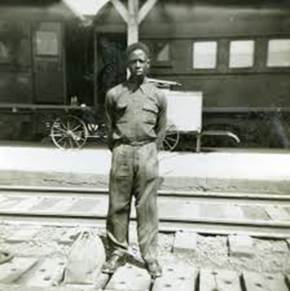
When Aaron got to the Clowns, he was hitting cross-handed. The team put his right hand on top, and he responded by leading the league in hitting. He left after three months to play for the Boston Braves farm team in Eau Claire. In 1953, the Braves moved to Milwaukee and Aaron played for their Jacksonville farm team. In 1954, he was in the majors. Below, his rookie card.
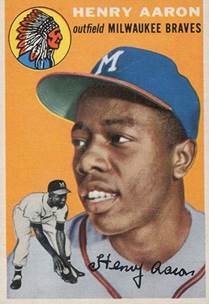
The back of the rookie card covered Aaron’s time in the minors, including his winning of watches and sport coats from local retailers for his feats at bat. He gave the watches to friends, but kept the sport coats to become “the best-dressed player in the league.” That was in Jacksonville In 1953. The year after that train station photo.

And in 1957, five years after the train station photo, Henry Aaron hit 44 homers (his uniform number) and was named MVP of the National League. He then led the Milwaukee Braves to a World Series victory over the Yankees.
He was just getting started.
Hank Aaron – The Numbers: Hank Aaron was much more than his numbers, but they are staggering. And he was not just a home run slugger. A popular stat that is often mentioned is that if you take away his 755 homers, Aaron would still have over 3,000 hits. Counting their home runs, Ruth nor Bonds had 3,000 hits.
Here’s another. Aaron had 6,856 total bases in his career – an amazing 722 more than second place Stan Musial. If Babe Ruth hit another 250 homers, he would still have fewer total bases than Hank Aaron.
He was a complete ballplayer. He stole 240 bases. Won three Gold Gloves. He holds the career record for RBIs (2,297). He was consistent year-after-year, hitting 755 home runs without ever having more than 47 in a season.
But the story always comes back to breaking Babe Ruth’s record.
The Difficult Road to #715: Aaron began the 1973 season with 673 homers. He needed to hit 41 to tie Ruth and 42 to break the record. Sports fans around the nation were watching. So were some racists who thought a Black man had no right to break Ruth’s sacred record.
An avalanche of mail came in, and Carla Koplin (below) handled the correspondence. To commemorate the over 900,000 pieces of mail in 1973, the post office gave him a plaque for being #1 in home runs and fan mail.
The bulk of the mail was favorable, but there was also a lot of hate mail and sometimes death threats. Carla Koplin would give some of the more threatening letters to the FBI, and the balance went to Aaron who kept them in his attic for reference over the years.
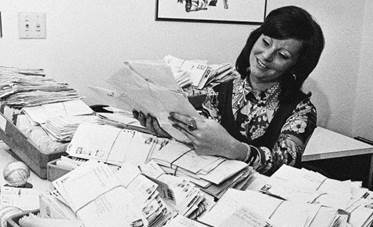
Charles Schulz, the creator of Peanuts, addressed the hate mail in a series of strips that ran in August of 1973.


Aaron was under tremendous pressure. Here is what he said in his 1991 autobiography (I Had a Hammer: The Hank Aaron Story):
“All that hatred left a deep scar on me. I was just a man doing something that God had given me the power to do, and I was living like an outcast in my own country. I had nowhere to go except home and to the ballpark…I was a prisoner in my own apartment. That whole period, I lived like a guy in a fishbowl, swimming from side to side with nowhere to go, watching everybody watching me…It should have been the most enjoyable time of my life, and instead it was hell.”


Snoopy’s season ended in a strip dated August 20. He stood at 713 homers and had one last chance to tie Ruth. Charlie Brown was on second base…


This last strip was prescient. Snoopy ended his season with 713 homers, putting him several homers ahead of Aaron at the time. But there were still six weeks to go in the MLB season. Aaron was able to catch Snoopy, but in a “life imitating art” moment, Aaron’s 40-homer season left him with the same cliffhanging 713, one short of Ruth. He spent the winter worried about being assassinated.
April 8, 1974 – #715: The Braves opened the 1974 season in Cincinnati, and Aaron hit one home run (#714) in the series. The team returned to Atlanta for the home opener on April 8. In Aaron’s first at bat, he walked and scored a run, breaking Willie Mays’ record for career runs. But that’s not the record the sold-out crowd came to see. In his second at bat, Aaron hit Al Downing’s 1-0 pitch over the fence for #715. The ordeal was over. The crowd of course went wild, and a couple of teenagers joined Aaron as he rounded the bases. He met a feeding frenzy of photographers at home plate. In a stroke of luck, the Braves were playing the Dodgers, so Vin Scully was on hand to make his memorable call (click here).
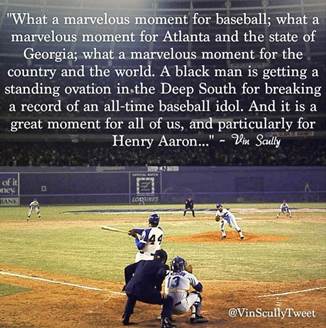
Baseball fans from all over celebrated.
Hot Stove reader Pat McInerney remembers that Aaron moment: “When I was 9, he was the largest ballplayer in my baseball universe as he chased the Babe, so I sent him a letter saying so and asking for a picture. I got one back with his autograph and thought I’d reached the pinnacle of life. I remember exactly where I was on April 8, 1974, when he hit 715 off Al Downing – at my grandparents’ home with my folks and brothers. What a night that was.”
Bob Kendrick also remembers it well. He was 11 years old and a fan of the Braves who played just 90 miles from his home in Crawfordville, Georgia. Hank Aaron was his boyhood hero. When Aaron circled the bases for #715, Bob says he ecstatically did the same in his living room, from first (couch) to second (TV) to third (another couch) to home (his mother’s recliner). In 1999, at a 25th anniversary celebration of that homer, an awestruck Bob Kendrick gave Hank Aaron a tour of the Negro Leagues Baseball Museum. Bob and his hero became good friends.
Life After Baseball: Aaron continued as an all-star after his playing days. Some examples. A businessman (BMW dealer). A philanthropist ($3 million to the Morehouse medical school). A Braves executive (placed Ned Yost in his first coaching and managing positions in the minor leagues).
And a civil rights activist. Aaron once told Martin Luther King that he was embarrassed that he had not been more public in support of the movement. As reported by Andrew Young, “Martin was a big baseball fan. We told him (Aaron) not to worry. We told him just keep hitting the ball. That was his job.” King would appreciate Aaron’s “Chasing the Dream Foundation” which promotes “programs to support the achievements of youth with limited opportunities and enable them to develop their talents and pursue their dreams.” Just like he said about himself when he was leaving that train station in 1952.
One of my favorite quotes about Aaron is in the first line of his biography at Cooperstown. It’s from Muhammad Ali who said Hank Aaron is “The only man I idolize more than myself.”
Hank Aaron and Ian: In the fall of 2015, after the little league season ended, I was taking my 10-year-old grandson Ian to the indoor batting cages for some batting practice. He brought along a book he had been reading – Sports Illustrated Baseball’s Greatest. He informed me that he did not agree with Sports Illustrated on its ranking of Babe Ruth over Hank Aaron in right field. Ian is very opinionated and Hank Aaron is his favorite all-time player. I told him I leaned toward Ruth, but they were great players from different eras.
At about the same time, the Royals won the pennant, and I took Ian to an ALCS game. On the Saturday night after the Royals won the World Series, Ian got a special treat. Rita and I took him to the 25th Anniversary Gala for the Negro Leagues Baseball Museum. The featured guest was Hank Aaron. Below, on stage at the event, three Hall of Famers: Ferguson Jenkins, Hank Aaron and Dave Winfield.
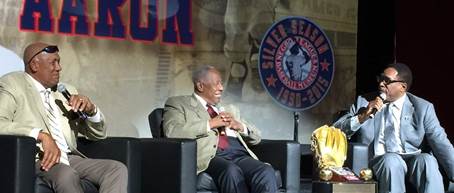
Ian took a ball to get autographs, but the opportunity never came up. I apologized to Ian for that, and he said he was very happy just to “be in the area” with Hank Aaron. In the room where it happened. We did get a nice shot of Ian with Hank’s poster at the event. [Ian update: He is now driving.]

The poster shows Aaron in the uniform of the Indianapolis Clowns of the Negro Leagues. Aaron always remembered his roots in the Negro Leagues and was a long-time supporter of the museum. Just this past year, Aaron appeared on the Today Show to honor the 100th anniversary of the founding of the Negro Leagues (click here) and participated with four former presidents, a space-station astronaut and others in the “tip your cap” campaign for the Negro Leagues (click here). With the death of Aaron, the sole surviving Hall of Famer who played in the Negro Leagues is Willie Mays (now 89).
Memorial and Funeral: At their stadium in Atlanta, the Braves have a walk-through Monument Garden that features their Hall of Fame players and highlights from franchise history. The center-point is a statue of Hank Aaron in front of a display of 755 Louisville Slugger bats arranged to match his career number of home runs. That’s me standing between Aaron and the bats. Rita and I were there on our 2018 stadium tour.

The Monument Garden was the venue for the memorial service held by the Braves. Speakers included Baseball Commissioner Rob Manfred and Braves players and officials. Several players spoke remotely for the socially-distanced event. Another participant appearing remotely was Bob Kendrick who spoke of Aaron’s connection to the Negro Leagues (click here for Bob’s remarks).
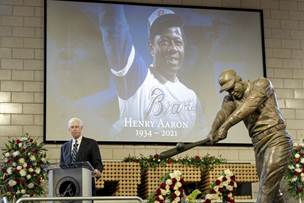
At the church funeral, the speakers included former commissioner Bud Selig, Ambassador Andrew Young, former President Bill Clinton, and (remotely) Bob Costas. Clinton and Aaron became friends in 1992 when Aaron endorsed Clinton for President. Below, Clinton at Aaron’s 75th birthday celebration.
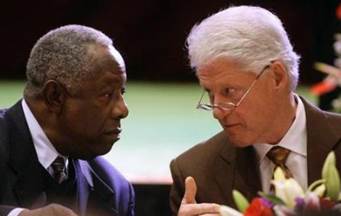
Here are some quotes from Clinton’s eulogy:
“When he retired from baseball, instead of becoming the man who used to be Hank Aaron, he just chased other dreams. He aspired to succeed in business and acquired the means to help others do things with their lives, and he did. He aspired to help young people overcome the barriers that he’d had to overcome by himself, and … through the ‘Chasing the Dream’ foundation, he did. He (aspired) to close the racial divide, not by tearing anybody down but by lifting people up, not by demeaning people but by opening their minds and opening their eyes and opening their hearts. And he did. And for that, Lord, (Aaron’s wife) Billye was the best teammate he ever could have had.”
“I think one reason he never got rid of all those boxes of hate mail he got… he kept it to remind himself that grace is not the absence of anger or resentment. It is the conscious choice not to surrender to them.”
Clinton spoke of how Aaron drew a crowd of 25,000 to a campaign rally in Georgia three days before the 1992 election. Clinton carried Georgia by 13,000 votes (the last time a Democrat won Georgia until Joe Biden won in 2020). Clinton said of Aaron, “And for the rest of his life, he never let me forget who was responsible for winning. Hank Aaron never bragged about anything except carrying Georgia in 1992, and he probably did.”
“His whole life…was one long home run, and now he has rounded the bases.”
Aaron’s grandson Raynal Aaron said one of his favorite quotes from his grandfather was, “I don’t want them to forget Ruth, I just want them to remember me.”
We will.
Paul Vardeman (91st Birthday): This coming Friday is Paul Vardeman’s 91st birthday. This would normally mean a dinner for Paul and nine of his former partners from the Polsinelli firm. We have been doing this for many years, but it never even got to the planning stage in this year of the pandemic.
In addition to Paul’s career as a respected lawyer and judge, and his well-earned reputation as a raconteur, he is an expert researcher and collector of scrimshaw. For decades, he has filled his home with hundreds (thousands?) of marine artifacts, many acquired while on vacations to Nantucket with his wife Connie. Below, a sample from the catalog for an auction when Paul sold a good part of his collection in 2019.
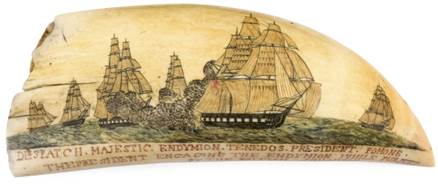
Sometimes called “the Dean of Scrimshaw,” Paul got some minutes of fame in 2012 on the TV show “America’s Lost Treasures” on the National Geographic channel. When you watch this 3-minute clip, you will see why we enjoy dinner with Paul.

Happy Birthday Paul!
Lonnie’s Jukebox (1) – Aaron Milestones: Henry Aaron’s career lasted 23 seasons. From early rock ‘n’ roll to stadium rock concerts.
Homer #1 (1954) – “Shake, Rattle and Roll” by Big Joe Turner. Two versions of this were released in 1954, the first by Kansas City blues shouter Joe Turner. A few months later it was covered by Bill Haley and His Comets (click here for that one).
Homer #500 (1968) – “Hey Jude” by the Beatles.
Hit #3,000 (1970) – “Ain’t No Mountain High Enough” by Diana Ross. I don’t think Diana was referring to baseball, but let’s say the mountain was 3,000 hits. Hank Aaron had 2,999 hits before playing against the Reds in a double-header on May 17, 1970. The most recent player to reach 3,000 hits was Stan Musial who had retired in 1963. Musial hopped on a plane to Cincinnati that morning so he could see his friend get number 3,000. He had to wait until the second game, but it happened and Musial jumped over the railing and went to the field to congratulate Aaron (below). Aaron often spoke fondly of Musial’s gesture (click here).
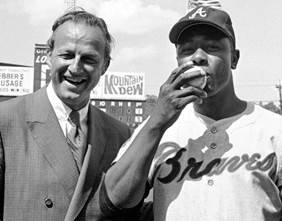
Homer #714 (1974) – “The Loco-motion” by Grand Funk Railroad. This is a cover of the 1962 hit by Little Eva. Both versions went to #1. The song was written by Gerry Goffin and Carole King and was selected so I could show off this photo of Rita and me with Carole King. It was taken at a John Kerry “living room” fundraiser in Kansas City in 2004.

Homer #715 (1974) – “I’m Left, You’re Right, She’s Gone” by Jerry Lee Lewis. This cover of the Elvis Presley 1955 hit was on the country chart in 1974. A clever blogger suggested it could be applied to Aaron homer #715. The pitcher Al Downing was left handed. Aaron batted from the right side. So Downing sings “I’m Left, You’re Right, She’s Gone.” “She” being #715.
Homer #755 (1976) – “Bohemian Rhapsody” by Queen. Over a billion views.
Lonnie’s Jukebox (2) – Chiefs: I’m anxious to see two highlights at the Super Bowl on Sunday. First, a Chiefs’ victory. Second, inaugural poet Amanda Gorman reciting an original poem about an educator, nurse manager and Marine Corps veteran selected by the league as “community heroes” and honorary captains.
For your Chiefs’ jukebox selection: Blake Howard in this “Run It Back” video.

Time to update the Union Station sign to Super Bowl Champions.
Go Chiefs!